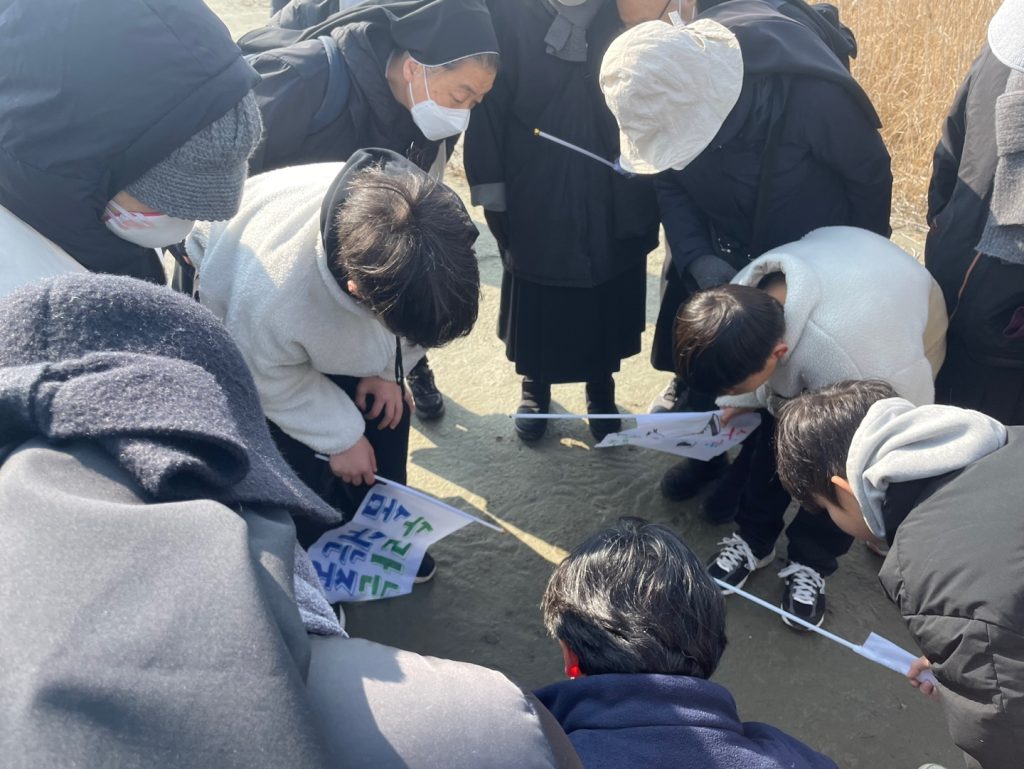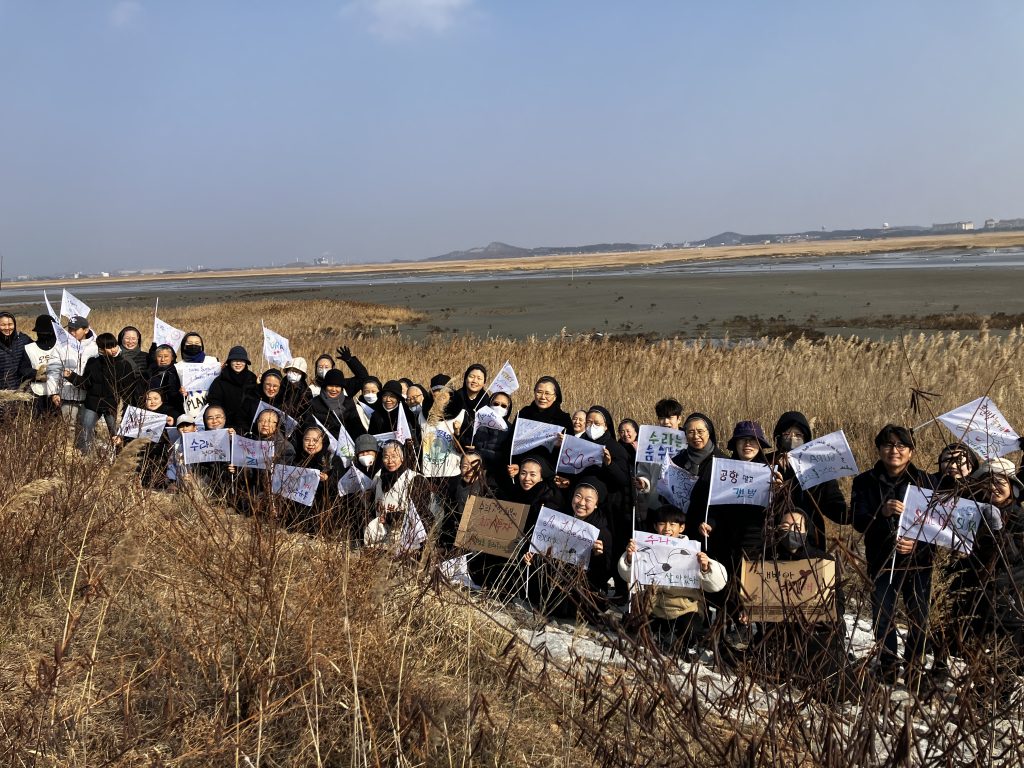The mud squished softly beneath their feet, a muted rhythm against the hushed expanse of the Saemangeum Gaetbol, a vast coastal wetlands along the Yellow Sea, hosting diverse sedimentary systems and supporting rich biodiversity, including migratory birds, endemic marine species, and traditional fishing communities. The air was heavy with salt, but something else lingered—a silence that wasn’t natural. The sisters of the Regina Pacis Province of the Congregation of the Sisters of Notre Dame had come here on a mission. This was a pilgrimage of hope, to a place where creation’s cries echoed against the embankments that now scarred one of the world’s greatest tidal flats.
For over a thousand years, the tidal flats had supported life in delicate balance, providing habitat for countless species and sustaining coastal communities. These wetlands, shaped by the ebb and flow of the Yellow Sea, nurtured vast beds of shellfish, fed migratory birds, and sustained generations of fishers who depended on their bounty. But in the late 1980s, government planners set their sights on transforming the landscape. The Saemangeum Development Project, officially launched in 1991, promised prosperity—fertile agricultural land to feed communities and fuel economic growth. To achieve this vision, engineers constructed a 33-kilometer seawall, the longest in the world, sealing off the tidal flats from the sea.
The consequences were devastating. Without the daily rhythm of the tides, the wetlands withered—shellfish suffocated, fish nurseries vanished, and the once-thriving ecosystem collapsed. Migratory birds, including endangered species that relied on these mudflats as a crucial stopover along the East Asian-Australasian Flyway, found their feeding grounds destroyed.
The Sacred Silence of Sura Gaetbol
Sura Gaetbol, the last remaining tidal flat in the area, was shimmering in the afternoon sun as the sisters approached it. They’d planned a community pilgrimage to the flat, to honor it as a reflection of the Creator and to pray for its protection. The name “Sura,” meaning “as beautiful as embroidered silk,” felt both a tribute and a lament. The beauty remained, but so did the scars—plans for an international airport and an expanded U.S. military base loomed over the fragile ecosystem.
“We placed ‘hope’ in our footsteps,” reflected Sr. Marie Carmel. “Even the cries of the earth we found beautiful, as we strived to become footsteps that bring good news.”
They moved carefully, whistling softly as they approached the habitats of migratory birds, signaling their presence to avoid startling them. The birds responded, some moving gently away, others pausing, as if acknowledging the quiet reverence in the sisters’ movements.

This was an embodiment of integral ecology, the belief that caring for creation is inseparable from caring for humanity. To protect the Earth is to protect ourselves, and in that awareness, the sisters found a sacred calling.
From Pilgrimage to Prophetic Action
The pilgrimage was only the beginning. The sisters returned to their ministries with a renewed purpose, integrating ecological awareness into their daily work. In kindergartens, schools, social welfare centers, and parishes, they shared the story of Saemangeum, not just as a place of ecological tragedy, but as a symbol of resilience and hope.
“The biggest change is the shift of consciousness among the sisters,” said Sr. Marie Carmel. “Those who were skeptical of social issues became more engaged, especially through the practices of the Laudato Si’ Action Platform.”
They organized documentary screenings and forums, inviting children and collaborators to learn about Sura Gaetbol. Sr. Marie Rufina, principal of the nearby Bakmoon Elementary School, led a screening of the documentary Sura, followed by a discussion with its director. Sr. Marie Noel from Notre Dame Rehabilitation Center, a local health facility, brought coworkers to visit the tidal flats themselves, witnessing firsthand the beauty and the pain.

Their advocacy extended beyond education. The sisters participated in public demonstrations, stood in solidarity with local activists, and contributed to petitions aimed at halting the airport construction. Their faith fueled their activism, and their activism deepened their faith.
A Theology of Togetherness
In reflecting on the pilgrimage, Sr. Marie Carmel drew parallels between their journey and the Gospel story of the disciples after Jesus’ resurrection.
“After Jesus’ resurrection, His disciples were at a loss. When Peter said, ‘I’m going fishing,’ the others replied, ‘We’ll come with you.’ They went together. What mattered wasn’t the catch but being together. I believe our attitude toward the Earth must be the same. Even when we feel weary, we must go out and act. Then, others will gather around us, saying, ‘We will come with you.’”
This message resonated deeply with those who heard it. In a world that is often paralyzed by the enormity of ecological crises, the sisters’ story is a testament to the power of collective action and faith-driven resilience. Hope, they discovered, is not passive; it is an active choice, a commitment to stand with creation even when the odds seem insurmountable.
A Call to Global Solidarity
The sisters’ pilgrimage to Saemangeum Gaetbol is part of a broader effort within the Laudato Si’ Action Platform, uniting the global Catholic community in the work to care for our common home. Their journey is a reminder that even in the face of profound environmental destruction, hope persists. It is found in the footsteps of those who refuse to look away, in the prayers whispered on tidal flats, and in the actions taken to protect what remains.
“Because of having witnessed such beauty, we cannot turn away,” said Oh Dong-Pil, a local activist. The sisters echoed this sentiment, vowing to continue their advocacy for Sura Gaetbol and all of creation.
Their story invites us all to consider: Where is our Saemangeum? What cries of the Earth are we being called to hear, and how will we respond?

Join the platform. Learn how your community can take action through the Laudato Si’ Action Platform. Together, we can be pilgrims of hope in a world that longs for healing.